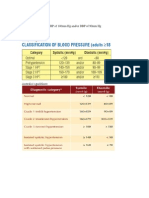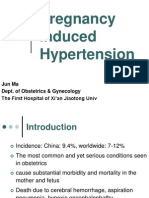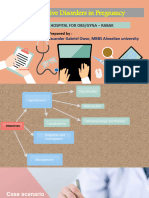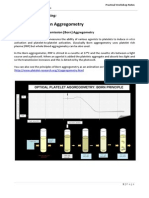0 ratings0% found this document useful (0 votes)
27 viewsNew Care Plans
New Care Plans
Uploaded by
bbarnes0912The nursing care plan is for an 80-year-old male patient admitted to the hospital for hematuria (blood in the urine) and hypertension. He reported pissing blood for a long time and having lower back pain. His diagnoses include hematuria, hypertension, dementia, lumbago, benign prostate hyperplasia, and a UTI. He is being treated with various medications including Vancomycin, Flomax, Norvasc, Diflucan, Hydrochlorothiazide, Zestril, Apresoline, and Tylenol. The plan provides background on the patient's conditions, signs and symptoms of his diagnoses, and a brief description of the pathophysiology of hypertension and hematuria.
Copyright:
© All Rights Reserved
Available Formats
Download as DOCX, PDF, TXT or read online from Scribd
New Care Plans
New Care Plans
Uploaded by
bbarnes09120 ratings0% found this document useful (0 votes)
27 views2 pagesThe nursing care plan is for an 80-year-old male patient admitted to the hospital for hematuria (blood in the urine) and hypertension. He reported pissing blood for a long time and having lower back pain. His diagnoses include hematuria, hypertension, dementia, lumbago, benign prostate hyperplasia, and a UTI. He is being treated with various medications including Vancomycin, Flomax, Norvasc, Diflucan, Hydrochlorothiazide, Zestril, Apresoline, and Tylenol. The plan provides background on the patient's conditions, signs and symptoms of his diagnoses, and a brief description of the pathophysiology of hypertension and hematuria.
Original Description:
Care plans for nursing 160A and 160D. Only required for certain schools or activities
Copyright
© © All Rights Reserved
Available Formats
DOCX, PDF, TXT or read online from Scribd
Share this document
Did you find this document useful?
Is this content inappropriate?
The nursing care plan is for an 80-year-old male patient admitted to the hospital for hematuria (blood in the urine) and hypertension. He reported pissing blood for a long time and having lower back pain. His diagnoses include hematuria, hypertension, dementia, lumbago, benign prostate hyperplasia, and a UTI. He is being treated with various medications including Vancomycin, Flomax, Norvasc, Diflucan, Hydrochlorothiazide, Zestril, Apresoline, and Tylenol. The plan provides background on the patient's conditions, signs and symptoms of his diagnoses, and a brief description of the pathophysiology of hypertension and hematuria.
Copyright:
© All Rights Reserved
Available Formats
Download as DOCX, PDF, TXT or read online from Scribd
Download as docx, pdf, or txt
0 ratings0% found this document useful (0 votes)
27 views2 pagesNew Care Plans
New Care Plans
Uploaded by
bbarnes0912The nursing care plan is for an 80-year-old male patient admitted to the hospital for hematuria (blood in the urine) and hypertension. He reported pissing blood for a long time and having lower back pain. His diagnoses include hematuria, hypertension, dementia, lumbago, benign prostate hyperplasia, and a UTI. He is being treated with various medications including Vancomycin, Flomax, Norvasc, Diflucan, Hydrochlorothiazide, Zestril, Apresoline, and Tylenol. The plan provides background on the patient's conditions, signs and symptoms of his diagnoses, and a brief description of the pathophysiology of hypertension and hematuria.
Copyright:
© All Rights Reserved
Available Formats
Download as DOCX, PDF, TXT or read online from Scribd
Download as docx, pdf, or txt
You are on page 1of 2
CUYAHOGA COMMUNITY COLLEGE
DEPARTMENT OF NURSING EDUCATION
NURSING CARE PLAN
Students name: Brian L. Barnes LPN
General Information
Patient initials: Date of Care: 03/25/14
Source of Data:
Patient Health Care Team Chart Family Other:
Age: 80 Sex: Male Martial Status: SINGLE Admission Date: 03/23/14
Religion: Baptist Advanced Directives: DNRCCA
Reason for Admission: Patient admitted for hematuria.
1 Primary Medical Diagnosis
Hematuria
Hypertension
2 Secondary Medical Diagnosis
Dementia
Lumbago
Benign Prostate Hyperplasia
UTI
3 Surgical procedures & dates
No previous surgical procedures
4 Reported signs & symptoms (use patients own words)
Patient stated, I came here because I was pissing out blood. I dont know why
they kept me this long because this problem been like this for a long time. I also
keep having this lower back pain that I just cant get rid of.
5 Signs and Symptoms of diagnoses as given in your text
Hypertension
HTN itself usually does not have any signs or symptoms
Some things may occur: flushing, headache, dizzy
Hematuria
Visible blood, pink, red or cola colored urine
Abdominal Pain
Decreased urinary force
Fever
Frequent urination (polyuria)
Pain during urination (dysuria)
Pain in the flank or side
Brief description of basic pathophysiology of present condition(s)
HTN: Blood pressure is a measure of how hard the blood pushes against the walls of your
arteries as it moves through your body. Its normal for blood pressure to go up and down
throughout the day, but if it stays up, you have high blood pressure. Another name for high
blood pressure is hypertension. When blood pressure is high, it starts to damage the blood
vessels, heart and kidnes. This can lead to heart attack, stroke, and other problems.
Hematuria: Presence of blood in the urine, an indication of injury or disease of the kidney or
some other structure of the urinary tract. The blood may become apparent during urination or
only upon microscopic examination. Rarely, blood may appear in the urine in the absence of
genito-urinary disease. Such instances may result from transfusion of incompatible blood, from
severe burns, from abnormal blood conditions in which the red cells are broken down.
MEDICAITONS & TREATMENTS:
Vancomycin (Vancocin) HCL 1250 gram via IV BID
Flomax (Tamsulosin) 0.4 mg QHS
Norvasc (Amlodipine) 10 mg QD
Diflucan (Fluconazole) 100 mg QD
Hydrochlorothiazide (Microzide) 25mg QD
Zestril (Lisinopril) 20 mg QD
Apresoline (Hydralazine) 10 mg via IV Q4HR PRN
Tylenol (Acetaminophen) 650mg Q6HR PRN
You might also like
- ABG Practice QuestionsDocument4 pagesABG Practice Questionsbbarnes0912No ratings yet
- Hypertension PresentationDocument97 pagesHypertension PresentationhawkansssNo ratings yet
- Hypertension in ChildrenDocument33 pagesHypertension in ChildrenkasondaNo ratings yet
- Uterine Fibroids Case StudyDocument38 pagesUterine Fibroids Case StudyFiona Cheryl Amsterdam80% (5)
- Nursing Care PlanllDocument5 pagesNursing Care Planllbbarnes0912No ratings yet
- BPHDocument34 pagesBPHBryan DorosanNo ratings yet
- Case Study HPTDocument16 pagesCase Study HPTIQmah RamliNo ratings yet
- High Blood Pressure - Google SearchDocument1 pageHigh Blood Pressure - Google Searchjknutson2121No ratings yet
- Med Surg 2 Pat 1Document24 pagesMed Surg 2 Pat 1api-315444338No ratings yet
- Askep HipertensiDocument23 pagesAskep HipertensiTikaNo ratings yet
- Hemolytic-Uremic Syndrome: CausesDocument3 pagesHemolytic-Uremic Syndrome: CausesDwi Budi UtamiNo ratings yet
- Deep Vein ThrombosisDocument33 pagesDeep Vein ThrombosisWisnu Cahyo100% (2)
- Vasucular DiseasesDocument43 pagesVasucular DiseasesSufiyan AbduramanNo ratings yet
- Case-study-Cardio-case-no.-1 (Esam Samskruthi)Document8 pagesCase-study-Cardio-case-no.-1 (Esam Samskruthi)Esam SamskruthiNo ratings yet
- STEMI Whole Anterior Onset 24 Hours Killip I: TIMI Score 6:14Document26 pagesSTEMI Whole Anterior Onset 24 Hours Killip I: TIMI Score 6:14Akbar IskandarNo ratings yet
- Cirrhosis and Its Complications Part 1 LenchoDocument76 pagesCirrhosis and Its Complications Part 1 Lenchoosman nurNo ratings yet
- Hypertension: Medlineplus TopicsDocument31 pagesHypertension: Medlineplus TopicsMcNover Catlin OsamNo ratings yet
- TrobositopeniaDocument3 pagesTrobositopeniaFurqon SugandiNo ratings yet
- Hypertensive Crisis: Megat Mohd Azman Bin AdzmiDocument34 pagesHypertensive Crisis: Megat Mohd Azman Bin AdzmiMegat Mohd Azman AdzmiNo ratings yet
- Gibson J Clinicalcts4 Nurs352Document5 pagesGibson J Clinicalcts4 Nurs352api-233137921No ratings yet
- Nusing Assessment Guide: Kidney Failure (CKD) Area: CCUDocument15 pagesNusing Assessment Guide: Kidney Failure (CKD) Area: CCUAbbas AwfiNo ratings yet
- HIPERTENSI Dan Penyakit KardiovaskularDocument39 pagesHIPERTENSI Dan Penyakit KardiovaskulardhestiNo ratings yet
- Return To Top: Alternative NamesDocument7 pagesReturn To Top: Alternative NamesDewi SNo ratings yet
- Surgery MnemonicsDocument6 pagesSurgery MnemonicsMarkoMilivojevic50% (2)
- Lupusand GIbleedDocument2 pagesLupusand GIbleedAshley Noonan SteereNo ratings yet
- Level 3 Lec 2 CardioDocument234 pagesLevel 3 Lec 2 CardioMaria Arlyn Lacuña SagosoNo ratings yet
- Priddy Conceptmap4Document5 pagesPriddy Conceptmap4api-345936257No ratings yet
- What Is Hypertensive NephropathyDocument11 pagesWhat Is Hypertensive NephropathyIvy Pamanian DeldaNo ratings yet
- Maffett Fundamentals Pat 2015Document16 pagesMaffett Fundamentals Pat 2015api-339784339No ratings yet
- Lecture 24-Gastrointestinal BleedingDocument13 pagesLecture 24-Gastrointestinal BleedingNaw YuNo ratings yet
- Abdul Rahim Bin Mohamad Nor C 111 10 871: Prof - Dr.Peter Kabo, PHD, SPFK, SPJP (K), Fiha, FasccDocument38 pagesAbdul Rahim Bin Mohamad Nor C 111 10 871: Prof - Dr.Peter Kabo, PHD, SPFK, SPJP (K), Fiha, FasccAis KonorasNo ratings yet
- HTN 4 NursesDocument50 pagesHTN 4 Nursesmesfin desalegnNo ratings yet
- Blood TransfusionDocument3 pagesBlood Transfusionjaja7lagunzadNo ratings yet
- Case PresentationDocument22 pagesCase PresentationVikaNo ratings yet
- Renal Departemen: Sih Winedar, Sri Rahayu, Susi Wulandari Vincesia Sulastri, Yuli Hartini, Yunita SetyaDocument17 pagesRenal Departemen: Sih Winedar, Sri Rahayu, Susi Wulandari Vincesia Sulastri, Yuli Hartini, Yunita Setyavincensia sulasNo ratings yet
- Magzine Hypertension 1Document16 pagesMagzine Hypertension 1Iqra UmaimaNo ratings yet
- Rhigh Blood PressureDocument12 pagesRhigh Blood PressureMlumun Kange IyoNo ratings yet
- Perivascular: Presented By: Jeanrose B. SangcomDocument22 pagesPerivascular: Presented By: Jeanrose B. SangcomJean SangcomNo ratings yet
- Persistent Elevation of SBP of 140mm HG And/or DBP of 90mm HG Classifications Malaysia's GuidelinesDocument4 pagesPersistent Elevation of SBP of 140mm HG And/or DBP of 90mm HG Classifications Malaysia's GuidelinesLaughin KowNo ratings yet
- Submitted To: Dr. Shimaa Said Course Name: Pathophysiology PATH 200 Submitted By: Hassna Maquta Ali Alharthy 2023101792Document8 pagesSubmitted To: Dr. Shimaa Said Course Name: Pathophysiology PATH 200 Submitted By: Hassna Maquta Ali Alharthy 2023101792Hassna AlharthyNo ratings yet
- Naturopathic Approaches For HypertensionDocument45 pagesNaturopathic Approaches For HypertensionMarissa CartyNo ratings yet
- Hypertension in PregnancyDocument49 pagesHypertension in PregnancyWaNda GrNo ratings yet
- HELLP Syndrome DR - SreevaniDocument29 pagesHELLP Syndrome DR - SreevaniNona Saudale100% (1)
- HypertensionDocument19 pagesHypertensionmr_coolz282344No ratings yet
- Hemolytic Uremic Syndrome 8.13.18Document34 pagesHemolytic Uremic Syndrome 8.13.18Emily EresumaNo ratings yet
- Acute Myocardial Infarction With ST Segment ElevationDocument26 pagesAcute Myocardial Infarction With ST Segment ElevationAkbar IskandarNo ratings yet
- HYPERTENSIONDocument55 pagesHYPERTENSIONviennns100% (4)
- Nutritional Strategies in Acute PancreatitisDocument19 pagesNutritional Strategies in Acute PancreatitisSyed Irfan ArifNo ratings yet
- Portal Vein Thrombosis, A Simple Guide To The Condition, Diagnosis, Treatment And Related ConditionsFrom EverandPortal Vein Thrombosis, A Simple Guide To The Condition, Diagnosis, Treatment And Related ConditionsNo ratings yet
- Hypertension: Detection, Evaluation and Non-Pharmacologic InterventionDocument55 pagesHypertension: Detection, Evaluation and Non-Pharmacologic InterventionSyarif MaulanaNo ratings yet
- Patent Ductus ArteriosusDocument48 pagesPatent Ductus ArteriosusPaul A IBattledaily ScavellaNo ratings yet
- Nursing Assessment: Nursing Care Plan For HypertensionDocument1 pageNursing Assessment: Nursing Care Plan For Hypertensionmaheru_chanNo ratings yet
- Intro DischargeDocument12 pagesIntro DischargegabrillotrishaNo ratings yet
- Hypertensive Disorder in PregnancyDocument56 pagesHypertensive Disorder in PregnancyESCA Gabriel100% (1)
- Nephrotic Syndrome Vs Nephritic SyndromeDocument46 pagesNephrotic Syndrome Vs Nephritic SyndromelilisNo ratings yet
- PSTHEDocument20 pagesPSTHEGamer ZionNo ratings yet
- HYPERTENSION DR - Ridwan SPJPDocument43 pagesHYPERTENSION DR - Ridwan SPJPAmanda PutraNo ratings yet
- Efusi Pleura Ec Ca ParuDocument33 pagesEfusi Pleura Ec Ca ParuRahma Putri KinasihNo ratings yet
- Hypertensive Crisis: Paguio, Leslie L. Pajarillo, Haidy Jance Pirmejo, Jeremiah JeromeDocument22 pagesHypertensive Crisis: Paguio, Leslie L. Pajarillo, Haidy Jance Pirmejo, Jeremiah JeromeLeslie PaguioNo ratings yet
- High Platelets, (Thrombocythemia) A Simple Guide To The Condition, Diagnosis, Treatment And Related ConditionsFrom EverandHigh Platelets, (Thrombocythemia) A Simple Guide To The Condition, Diagnosis, Treatment And Related ConditionsNo ratings yet
- Portal HypertensionDocument23 pagesPortal HypertensionSumathi Gopinath100% (1)
- Gastrointestinal Hemorrhage: Carolyn A. Sullivan, MD Pediatric GastroenterologyDocument24 pagesGastrointestinal Hemorrhage: Carolyn A. Sullivan, MD Pediatric GastroenterologyRuntika DewiNo ratings yet
- B Barnes ResumeDocument7 pagesB Barnes Resumebbarnes0912No ratings yet
- Cuyahoga Community College Department of Nursing Education MINI NURSING CARE PLAN (Clinical Prep Form)Document3 pagesCuyahoga Community College Department of Nursing Education MINI NURSING CARE PLAN (Clinical Prep Form)bbarnes0912No ratings yet
- Otc Medication: Weekly Checklist & Order Form: Nurse Date Time Bin # Medication Name Amt in Stock Amt NeededDocument3 pagesOtc Medication: Weekly Checklist & Order Form: Nurse Date Time Bin # Medication Name Amt in Stock Amt Neededbbarnes0912No ratings yet
- Alexander Langshaw - Giving Substance To Form: Towards An Integrated Governance Model of Transboundary Environmental Impact AssessmentDocument18 pagesAlexander Langshaw - Giving Substance To Form: Towards An Integrated Governance Model of Transboundary Environmental Impact AssessmentAlex LangshawNo ratings yet
- Layoff and RetrenchmentDocument6 pagesLayoff and RetrenchmentMohd SuhailNo ratings yet
- Oligopoly: Strategic Decision Making in Oligopoly MarketsDocument12 pagesOligopoly: Strategic Decision Making in Oligopoly Marketsakshat mathurNo ratings yet
- Trench Crusade V 1.4. Key ChangesDocument31 pagesTrench Crusade V 1.4. Key ChangesBig CraigNo ratings yet
- 33-ODOT Prestressed Design FINALDocument444 pages33-ODOT Prestressed Design FINALMustafa UzyardoğanNo ratings yet
- The Practice of Law Is A Noble ProfessionDocument3 pagesThe Practice of Law Is A Noble ProfessionKen TuazonNo ratings yet
- SE Project Report Template OBE - v2Document7 pagesSE Project Report Template OBE - v2Cadet AdnanNo ratings yet
- Additional Notes - Light Transmission Aggregometry NotesDocument7 pagesAdditional Notes - Light Transmission Aggregometry NotesAndrej TerzicNo ratings yet
- Advanced English VocabularyDocument3 pagesAdvanced English VocabularyAbbasov RaminNo ratings yet
- Catholic Social Teaching Assessment Task (Submission)Document13 pagesCatholic Social Teaching Assessment Task (Submission)Ralish MeasNo ratings yet
- The Definitive Guide To 120+ Nootropic Supplements & DrugsDocument70 pagesThe Definitive Guide To 120+ Nootropic Supplements & DrugselshikarNo ratings yet
- 2019 (George, Walker, & Monster) Does Strategic Planning Improve Organizational Performance A Meta-AnalysisDocument10 pages2019 (George, Walker, & Monster) Does Strategic Planning Improve Organizational Performance A Meta-AnalysisDwi Oki RahmawatiNo ratings yet
- Chapter 5 MC QuestionsDocument5 pagesChapter 5 MC Questionsjessica50% (2)
- ETEEAP Marla PisoNetDocument17 pagesETEEAP Marla PisoNetLouis Archie Dreyfus Perez0% (1)
- Case Analysis Question No. 1Document2 pagesCase Analysis Question No. 1Noel Jun LinganayNo ratings yet
- 5 - RelativesDocument16 pages5 - RelativesGrigore AdrianaNo ratings yet
- Journal of English Language Teaching: Aulia Putri and RefnaldiDocument12 pagesJournal of English Language Teaching: Aulia Putri and RefnaldiSunarti SulemanNo ratings yet
- Basset ForceDocument4 pagesBasset ForceDavid Alejandro GranadosNo ratings yet
- Target Listening 1Document11 pagesTarget Listening 1HELP ACADEMYNo ratings yet
- Marketing Management 14th Ed Chapter 14Document28 pagesMarketing Management 14th Ed Chapter 14dea_day521No ratings yet
- DOD YugoslaviaDocument100 pagesDOD YugoslaviaHakan YağdıNo ratings yet
- DSI PS HDAR-GR 200 25nov19 092724Document19 pagesDSI PS HDAR-GR 200 25nov19 092724kobay101No ratings yet
- BUS1011-Activity TwoDocument2 pagesBUS1011-Activity Twobhavarthind008No ratings yet
- Quick Lathe User Guide 1.1.0Document3 pagesQuick Lathe User Guide 1.1.0Vivek DubeyNo ratings yet
- Lalita Kumari vs. Govt. of U.P.: AIR 2012 SC 1515Document3 pagesLalita Kumari vs. Govt. of U.P.: AIR 2012 SC 1515Loveleen PandayNo ratings yet
- Car LoanDocument101 pagesCar LoanHarsimar Narula100% (2)
- Tektronix, Inc.: Global ERP ImplementationDocument27 pagesTektronix, Inc.: Global ERP ImplementationSURYANo ratings yet
- Dental ExamDocument25 pagesDental ExamPaulo Justin Tabangcora OropillaNo ratings yet
- Name: Marijo D Dalman Bsed-Filipino III Deadline: March 25, 2022 Unit 2 Teaching As A Vocation and MissionDocument11 pagesName: Marijo D Dalman Bsed-Filipino III Deadline: March 25, 2022 Unit 2 Teaching As A Vocation and MissionJudy Ann B. GordilloNo ratings yet
- 100325070351privatisation in Sri Lanka - A Socio-Economic Perspective - 2Document5 pages100325070351privatisation in Sri Lanka - A Socio-Economic Perspective - 2darshani sandamaliNo ratings yet






























































































